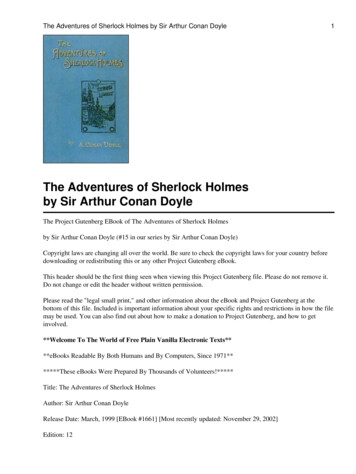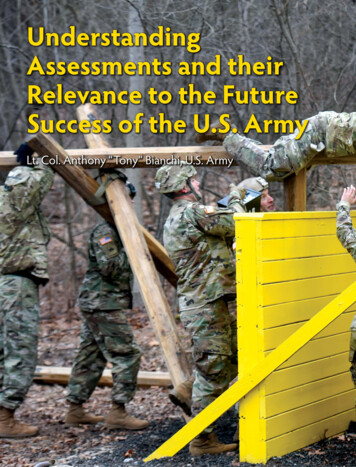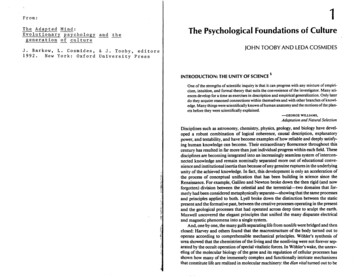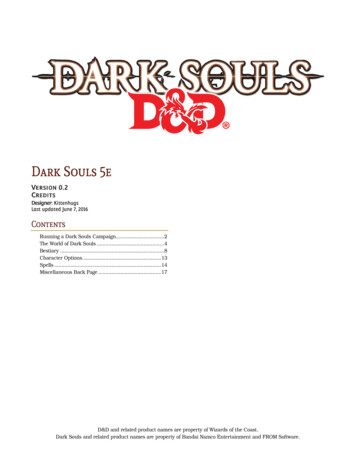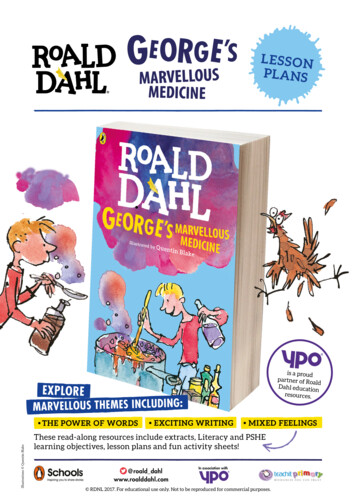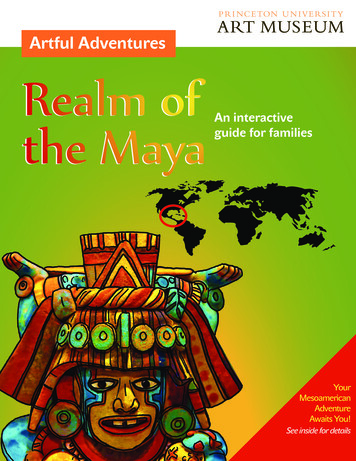
Transcription
Artful AdventuresRealm ofthe MayaAn interactiveguide for familiesYourMesoamericanAdventureAwaits You!See inside for details
MesoamericaArtful AdventuresOur journey today takes us to the galleriesof the ancient Americas, where we will lookat objects from the Maya, a group that, at itsheight, covered one third of Mesoamerica.These galleries are on the lower level of theMuseum. Walk down the stairs and turn right.Walk through the ancient Greek and Egyptiangalleries and turn right again, into the galleriesof the ancient Americas.read their writing, we have been able to learna great deal about the ancient Maya people.Find the Maya area of the map (green). This areais part of present‑day Mexico, Guatemala, Belize,Honduras, and El Salvador. The Maya lived incity-states ruled by kings and developed a veryaccurate calendar, thanks to Maya astronomers.They were excellent mathematicians and deviseda complicated form of writing. Because we canMAYA BEAUTYThe Maya thought that this woman was verybeautiful. Look at the shape of her head: it islong and pointed, with her hair in a tight bun andstepped bangs. The Maya liked this pointed shapebecause it looks like a corncob. Corn, or maize,was an important crop for the Maya. They dependedon it for food and believed that all good thingscame from corn. They even believed that peoplewere made from corn dough. The Maya wrappedbabies’ heads tightly with cloth, shaping theirheads like this woman’s.The painted designs on this woman’s cheeks wereprobably intended to represent her breath, whichthe Maya believed was a person’s spirit, or lifeforce. If you look carefully, you can see a holethrough the front of her nose where a nose beador tube once was. The paint on her cheeks mightalso be decorative extensions of this bead or tube.Central(?) lowlands, Maya area, Mexico or Guatemala, Late Classic, Maya,Kneeling noble woman holding a lidded jar, A.D. 650–750. Ceramic withpolychrome slip. Museum purchase, Fowler McCormick, Class of 1921, Fund(2005-65 a-b). Photo: Bruce M. White.
She wears a painted necklace and she probably once had earrings. Note that herface is painted red and white, as if she were wearing makeup. The Maya, like manycultures, valued personal ornamentation, things they wore to decorate their bodies.The ornamentation a person wore told others which family he or she was fromand how powerful they were.Find these objectsMaya, Early Classic, Earflares in the form of flowers, A.D. 350–600.Jadeite. Promised bequest of Gillett G. Griffin (L1985.67)Maya, Late Classic, Earflares in the form of flowers, a.d. 600–800. Conch shell.Gift of Gillett G. Griffin (2003-25 a–d)These are earflares, ornaments worn in the earlobe. Maya nobles pierced theearlobes of their children, both male and female, when they were babies. As achild grew, larger ornaments were inserted to make the holes bigger. Theseearflares are in the shape of flowers. One pair was carved from jade, and theother was carved from a conch shell; both are rare and precious materials.Why do you think the artists chose to make these earflares look like flowers?Perhaps these earflares look like flowers because the Maya believed that breath,one’s soul or life force, was fragrant and exited the body through all of the openingsin the head. Another possibility is that they thought that flowers, which are beautifuland smell nice, would have made the sounds that the person heard also nice.Can you think of examples of personal ornamentation that people wear today?Do these things tell you anything about the person’s culture, or the groups they areassociated with?
CYLINDER VESSELSLook at the side of the vessel that shows the scene depicted in the image on theleft. The figure in this scene is a god of the Underworld, sitting on a throne in apalace. We call him God L. He is very old and has no teeth. An owl is perched on thetop of God L’s hat, which has owl feathers as well as feathers from the quetzal bird.The Maya loved quetzals for their bright, colorful feathers and long tails. They wouldcatch live birds, pluck their tail feathers, and let them go.Nakbé region, Central lowlands, Mayaarea, Petén, Guatemala, Late Classic, Maya(‘Codex’ style), The Princeton vase, A.D.600–800. Granular gray-buff ceramic, mineralinclusions with orange-red and brown-blackslip decoration. Museum purchase, gift ofthe Hans A. Widenmann, Class of 1918, andDorothy Widenmann Foundation (y1975-17).Photo: Bruce M. White.Below: detailGod L is tying a bracelet on the wrist of the woman in front of him. The Maya wouldhave thought that this woman was very beautiful. Look at the top of her head. Doesthe shape and long flowing hair remind you of the Maya woman we looked at earlier?Can you find the rabbit under God L’s throne? He is writing something. What do youthink he is writing?Walk around the vase to the right and find the image shown on the left. Thiswoman is pouring liquid from a vessel that looks just like this one. What do youthink she is pouring?Did you guess chocolate? You are correct!Mesoamericans were the first people to make chocolate. They did not eat chocolatebars; they drank chocolate. Making chocolate is not easy. It is made from the podsof the cacao (pronounced kah KOW) tree. The pods of this tree have seeds that canbe made into chocolate. The Maya would roast the seeds, grind them into a paste,and mix the paste with water, chili peppers, cornmeal, and other ingredients. Thelast step in making the chocolate is shown on this vase. The woman is pouringthe chocolate back and forth between a cup and a pot, which made the chocolatefrothy. How do you think Maya chocolate would taste?bitter sweet spicy syrupy
Have you noticed the shapes around the top of most of the vessels in these cases?These are Maya glyphs, or writing. Instead of using an alphabet, the Maya wrote withpictures called hieroglyphs. Some of the pictures represent whole words, while othersrepresent a sound or a syllable. This glyph, for example, means cacao, or chocolate:Can you find it on any of the vessels in the cases?cax2waca ca waThe writing on this vase tells us what is happening in the scene. The glyph directly abovethis scene tells us that the vase held chocolate. The writing also tells us that the personwho owned this pot was named Bird Quetzal and that he was from the south.Writing ActivityNUMBERSThe Maya wrote their numbers using a dot for 1 and a bar for 5. Zero was a shell shape.014619Now try writing your phone number the way the Maya would!This text is from a children’s guide to the exhibition Courtly Art of the Ancient Maya, held in 2004–05 at the National Gallery, Washington, D.C., and the Fine Arts Museum ofSan Francisco, California Palace of the Legion of Honor.
Find the case of small human figurines in the center of the gallery.Look carefully at the figures and think about what you see. What arethey wearing? What does their clothing tell you about these people?How old are they? How can you tell?I SPY.1. Can you find a man with a large ring around his waist and a birdon his head?This is a ballplayer. The Maya played an early team sport called theballgame, in which they struck the ball with their hips. The padding thisman wears around his waist would have protected him from the heavyrubber ball. The bird headdress might have been used to distinguishone team from another.2. Can you find a man wearing a feather cape and a loincloth?This man’s open mouth, large chest, and open arms make us think hemay have been a court singer.3. Can you find a woman with a fierce face who is holding a shield?This is the Maya goddess Chak Chel. She is dressed as a warrior becausethe Mesoamerican people considered giving birth to be the femaleequivalent of men going to war.
Thank you for joining us today to explore the art of Mesoamerica. Don’tforget to stop at the Information Desk to collect a sticker for your ArtfulAdventures Passport. We hope that you enjoyed your visit to the PrincetonUniversity Art Museum and that you join us for another Artful Adventure!On the following pages you will find suggestions for ways that you cancontinue your Mesoamerican Adventure at home:Art Project: Makinga Maya Chocolate PotSupplies:Construction paper or cardstockColored pencilsTapeTake a piece of construction paper or card stock and fold it in halflength‑wise. This will be the outside of your pot.Make up a short story for your pot. It can be a story that you create oryou can use a favorite story that you already know. You can tell yourstory in words first: write it on a piece of paper or have a grown-up writeit for you.Now choose three scenes or characters from your story to draw on yourpot. Divide the folded paper into three sections and draw your threescenes or characters.When you are finished, roll the paper into a cylinder and tuck one endinto the other. Tape the two ends together.
Suggested ReadingMiro in the Kingdom of the Sun, by Jane Kurtz and DavidFrampton (woodcuts)In this folktale a young Inca girl succeeds where her brothers andothers have failed, when her bird friends help her find the specialwater that will cure the king’s son.(Gr K–3)Aztec, Inca, and Maya, by Elizabeth BaquedanoThis book chronicles the history, beliefs, and everyday lives of theancient Aztec, Inca, and Maya peoples.(Gr 3–5)Amazing Maya Inventions You Can Build Yourself, by Sheri Bell‑RehwoldtThis rich resource combines historical facts about the Maya with entertaining and educational craftprojects.(Gr 3–6)National Geographic Investigates Ancient Inca: Archaeology Unlocks the Secrets of the Inca’s Past, by BethGruber and Johan Reinhard (consultant)Photographs and illustrations pepper this informative guide to recent archeological finds and what theytell us about the Inca.(Gr 3–7)Before Columbus: The Americas of 1491, by Charles C. MannThis study of Native American societies is adapted for younger readers from Charles C. Mann’s bestselling 1491. Turning conventional wisdom on its head, the book argues that the people of North and SouthAmerica lived in enormous cities, raised pyramids hundreds of years before the Egyptians did, engineeredcorn, and farmed the rainforests.(Gr 6 )All of these books can be found in the children’s section of the Princeton Public Library.Copyright 2016 by the Trustees of Princeton University.
MesoamericaArtful Adventures Our journey today takes us to the galleries of the ancient Americas, where we will look at objects from the Maya, a group that, at its . one’s soul or life force, was fragrant and exited the body through all of the openings in the head. Another possibili


